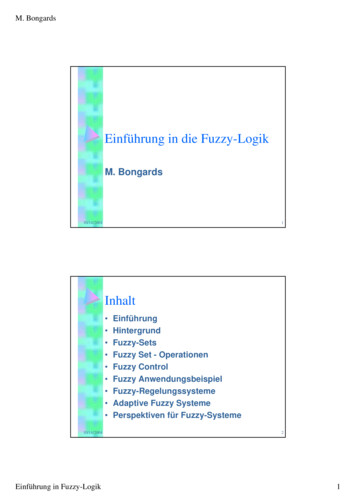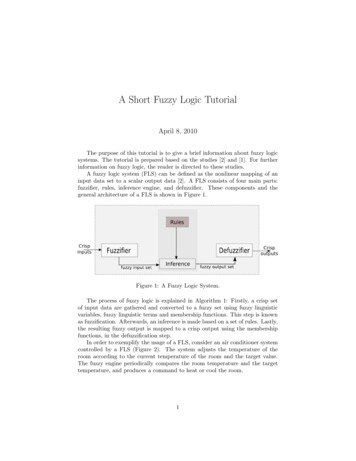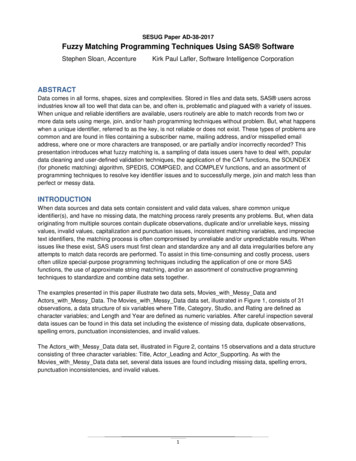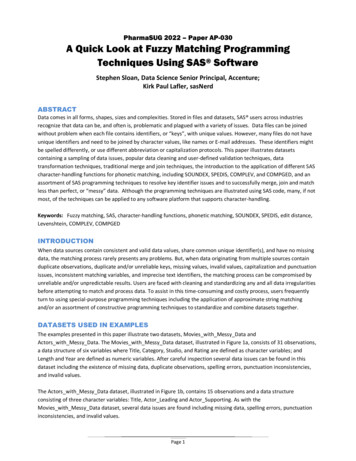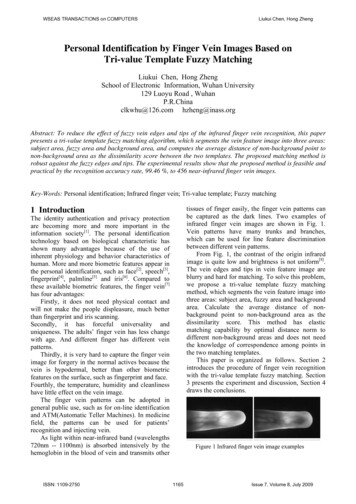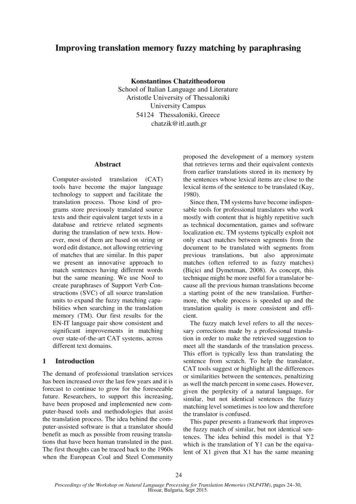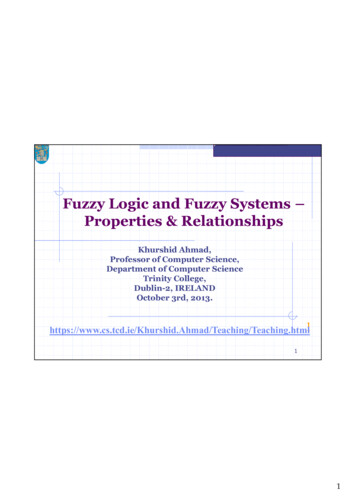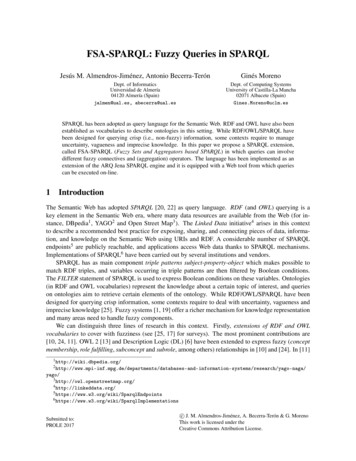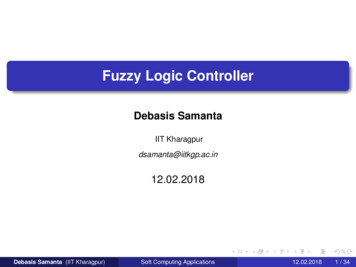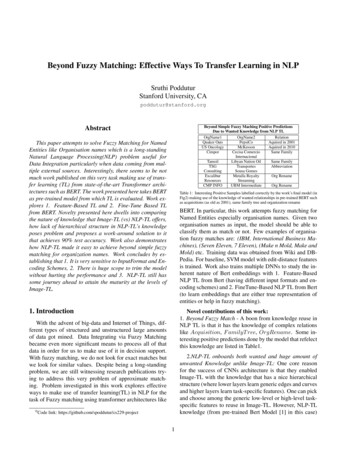
Transcription
Beyond Fuzzy Matching: Effective Ways To Transfer Learning in NLPSruthi PodduturStanford University, CApoddutur@stanford.orgBeyond Simple Fuzzy Maching Positive PredictionsDue to Wanted Knowledge from NLP TLOrgName1OrgName2RelationQuaker OatsPepsiCoAquired in 2001US OncologyMcKessonAquired in 2010CimporCecisa ComercioSame FamilyInternacionalTamoilLibyan Nation OilSame FamilyTSGTransportesAbbreviationConsultingSousa GomesExcaliburMetalla RoyaltyOrg RenameResourcesStreamingCMP INFOUBM IntermediateOrg RenameAbstractThis paper attempts to solve Fuzzy Matching for NamedEntities like Organisation names which is a long-standingNatural Language Processing(NLP) problem useful forData Integration particularly when data coming from multiple external sources. Interestingly, there seems to be notmuch work published on this very task making use of transfer learning (TL) from state-of-the-art Transformer architectures such as BERT. The work presented here takes BERTas pre-trained model from which TL is evaluated. Work explores 1. Feature-Based TL and 2. Fine-Tune Based TLfrom BERT. Novelty presented here dwells into comparingthe nature of knowledge that Image-TL (vs) NLP-TL offers,how lack of hierarchical structure in NLP-TL’s knowledgeposes problem and proposes a work-around solution to itthat achieves 90% test accuracy. Work also demonstrateshow NLP-TL made it easy to achieve beyond simple fuzzymatching for organization names. Work concludes by establishing that 1. It is very sensitive to InputFormat and Encoding Schemes, 2. There is huge scope to trim the modelwithout hurting the performance and 3. NLP-TL still hassome journey ahead to attain the maturity at the levels ofImage-TL.Table 1: Interesting Positive Samples labelled correctly by the work’s final model (inFig2) making use of the knowledge of wanted relationships in pre-trained BERT suchas acquisitions (as old as 2001), same family tree and organization renameBERT. In particular, this work attempts fuzzy matching forNamed Entities especially organisation names. Given twoorganisation names as input, the model should be able toclassify them as match or not. Few examples of organisation fuzzy matches are: (IBM, International Business Machines), (Seven Eleven, 7 Eleven), (Make n Mold, Make andMold) etc. Training data was obtained from Wiki and DBPedia. For baseline, SVM model with edit-distance featuresis trained. Work also trains multiple DNNs to study the inherent nature of Bert embeddings with 1. Feature-BasedNLP TL from Bert (having different input formats and encoding schemes) and 2. FineTune-Based NLP TL from Bert(to learn embeddings that are either true representation ofentities or help in fuzzy matching).1. IntroductionNovel contributions of this work:1. Beyond Fuzzy Match - A boon from knowledge reuse inNLP TL is that it has the knowledge of complex relationslike Acquisition, F amilyT ree, OrgRename. Some interesting positive predictions done by the model that refelectthis knowledge are listed in Table1.With the advent of big-data and Internet of Things, different types of structured and unstructured large amountsof data got mined. Data Integrating via Fuzzy Matchingbecame even more significant means to process all of thatdata in order for us to make use of it in decision support.With fuzzy matching, we do not look for exact matches butwe look for similar values. Despite being a long-standingproblem, we are still witnessing research publications trying to address this very problem of approximate matching. Problem investigated in this work explores effectiveways to make use of transfer learning(TL) in NLP for thetask of Fuzzy matching using transformer architectures like0 Code2.NLP-TL onboards both wanted and huge amount ofunwanted Knowledge unlike Image-TL: One core reasonfor the success of CNNs architecture is that they enabledImage-TL with the knowledge that has a nice hierarchicalstructure (where lower layers learn generic edges and curvesand higher layers learn task-specific features). One can pickand choose among the generic low-level or high-level taskspecific features to reuse in Image-TL. However, NLP-TLknowledge (from pre-trained Bert Model [1] in this case)link: https://github.com/spoddutur/cs229-project1
Incorrect Model PredictionsDue to UnWanted Knowledge from NLP TLOrgName1OrgName2RelationPenn State UnivKent State UnivSI,SCUniv of IowaUniv of ompetitorsPolytecnic Inst NYUWorcesterSI,SCPolytecnic InstTowa BankUnited WesternSI,DCBankilar entities have identical signatures with high probability [11, 14]. The most recent work on this task focusedon providing deep learning (DL) solutions [6] where it designed a pairwise binary classification task using logisticloss; Triplet Learning [9] which learns good embeddings forobjects using triplet loss and Siemese networks [13] whichtries to learn good entity embeddings in vector space usingcontrastive loss. Some other DL solutions include proposing a scoring technique for company names in [8], RNNbased classifiers [12]. However, until NLP-TL moment arrived, all these solutions had to learn their layer’s featuresfrom scratch. With the recent advancement of transformers[17], NLPs ImageNet moment has arrived i.e., they enabledtransfer learning in NLP. New challengers such as Elmo[15], ULMFit [10], Bert [5] etc made headlines providingpertained models that achieved state-of-the-art results on awide range of NLP tasks. However, there seems to be notmuch work published on Fuzzy matching for Named Entities using Transformer architectures.Table 2: Samples of incorrect predictions (as fuzzy match) by the work’s finalmodel(Fig2) making use of knowledge of unwanted relationships in pretrained-BERTlike SI SameIndustry,SC SameCountry,DC DifferentCountry,Competitors.do not have such hierarchical structure to it. Therefore,NLP-TL on-boards both wanted knowledge as well as muchbigger unwanted knowledge. User cannot pick and chooseonly the wanted knowledge to reuse in NLP-TL. For thistask, this unwanted knowledge that led to wrong predictionsconstitute Competitors, Same Industry, Shared-location etcrelationships as listed in Table 2.3. Cause for no hierarchy in NLP-TL Knowledge: As discussed above, Knowledge from NLP-TL does not have hierarchical structure to it and the reason is the very design ofthe transformers which is based solely on attention mechanism. Hence, NLP-TL has barely scratched the surface andneeds more cultivation in this direction. It has some journeyto travel before it could attain the maturity at the levels ofImage TL.4.Pre-process block: Because NLP-TL has the lack of control on selecting specific knowledge to reuse, there is a forcing need to have a pre-blocking component to filter all of theunwanted knowledge.Other Findings:1.Feature Based TL is sensitive to InputFormat andEncodingScheme: hCLSi Orgname1 hSEP i Orgname2hSEP i input format with Mean of the last 3 layers encoding scheme gave the best result with feature-based TL.However, even with this combination it could not out-beat asimple baseline model with barely 4 edit-distance features.Both gave same 85% accuracy.2. FineTune TL has faster convergence and has more learning ability than Feature-based TL.3. FineTune based model could be trimmed to half the sizewithout hurting performance4.Differential learning rate based fine tuning did not helpmuch in performance for this task5. Contrastive loss was used to try and learn true embeddings to entity. But, it is observed that without harnessingmuch harder triplets it might not be good at this task3. Data CollectionA total of 20,000 training data and 5,000 testdata was collected for this task.Positive samples are collected from WikiData (Example Entity:https://www.wikidata.org/wiki/Q37156) and DBPedia withcustom sparql queries [3] to extract Names and Aliases oforganisations. 10,000 strategic negative cases were curatedusing (a) Random combinations of organizations For example, (Microsoft, Apple) is one such negative case of this category and (b) Interpolating different name parts and designation parts. For example: (AIG Insurance, Oriental Insurance) and (Atlantic Traders, Atlantic RealEstates) are twosuch negative cases of this category. Also, to curate suchnegative cases, data was pre-processed to extract designation part and name part given an organization name. Table1and Table2 lists sample data.4. Method - ML Techniques triedThe main intent behind the experiments conducted in thiswork is to compare and analyze the nature of various formsof transfer learning in the latest transformer-based models and Bert is the chosen transformer-based model for thisanalysis in this work. Experiments attempted in this workcan be categorized broadly into three: Baseline, FeatureBased Transfer Learning and Fine-Tuning based TransferLearning.Consider a neural network function N with parameters w:N φw (x). Transfer learning from neural network Nto learn a new task is to compose it with a new function,ψv , to yield ψv (φw (x)). Here v constitutes the new taskspecific parameters and w constitutes the original parameters of N . Feature-based transfer learning is an approach2. Related WorkEarly Work on fuzzy matching typically used Rule-basedsolutions [7, 16] which are interpretable but require theheavy involvement of a domain expert. Later came localitysensitive hashing methods which in general provide entities with blocking keys/signatures in such a way that sim2
nce RatioMean ofpositive samples-0.1143390.2116040.4497720.327430Mean ofnegative ar SVMwith C 1RBF SVMwith C 10Table 3: Mean Differences of features between positive and negative samples illustrate presence of nice patterns captured by them for the model to estRecall76.8585.9385.5088.1977.44Table 4: Results of RBF vs Linear SVM model Based on Edit Distance Features.where we freeze w and train only v vs Fine-tuning transferlearning is an approach where both w and v form the trainable parameters.For Baseline, this work will start off with the most commonsolution for this problem where a simple statistical modelsuch as SVM is trained using simple string edit distancefeatures. Later, this work will move to current advancedattention-based transformer architectures such as BERT etal. [5] and attempt Feature-Based and Fine-Tuning basedtransfer learning methods on top of BERT to evaluate howits pre-trained embeddings [1] will perform for this task. Itwas also observed that the model was over-fitting data andso, Early Stopping and Dropout techniques were used.DNN1 ArchitectureF1, E1Dense(10)Dense(1)DNN4 ArchitectureF2, E1Dense(256),Dropout(0.2)Dense(10)Dense(1)DNN2 ArchitectureF1, se(1)DNN5 ArchitectureF2, E2Dense(256),Dropout(0.2)Dense(10)Dense(1)DNN3 ArchitectureF1, E1Dense(256),Dropout(0.2)Dense(10)Dense(1)Table 5: Architecture of DNN1 to DNN5.F1(Format1) CONCAT(BertEmbedding(OrgName1), Bert-Embedding(OrgName2)).F2( Format2) hCLSi OrgN ame1 hSEP i OrgN ame2 hSEP i. E1(Encoding Scheme1) Berts last Encoder Layer embedding. E2(Encoding Scheme2) Mean of Berts last 3Encoder Layers embedding5.2. Experiment2Feature-Based Transfer learning DNN using Bert’sPretrained Model: In this category, Bert is our neuralnetwork N from which transfer learning is attempted. Aswe are attempting feature-based learning Bert‘s weights arefrozen in this case. The experiments tried in this categorymainly differ in the input data format and what encoder layers output from Bert are consumed. The two input data formats tried in these experiments are:1. Format1: Get BertEmbeddings for OrgName1 andOrgName2 input strings; Concatenate these embeddingsand pass it to Dense layers down the lane.2.Format2: Get BertEmbedding for input stringhCLSi OrgN ame1 hSEP i OrgN ame2 hSEP i and passit to Dense layers down the lane.The two ways in which encoder outputs are consumed are:1. EncOutput1: Take Last Encoder Layer Output2. EncOutput2: Take Mean of Last 3 Encoder LayersDNN1, DNN2 and DNN3 are the three different DNNs triedwith fixed input format and encoder output i.e., Format1 andEncOutput1 but different architectures as briefed in Table5.Based on validation accuracy, the idea was to pick the bestout of these three architectures for further analysis whereinput format and encoder output are changed to compareand analyse their effects on model performance. DNN3 performed marginally better among the three with 80% validation accuracy. So, DNN3’s architecture was adapted for further analysis in DNN4 and DNN5 experiments i.e., DNN4and DNN5 use the same network architecture as DNN3 butthe input format and encoder output are changed to Format2and EncOutput2. Table5 shows the architecture of DNN4and DNN5 respectively.Results: Figure 1 illustrates the Train and ValidationAccuracy curves of DNN1, DNN2, DNN3, DNN4 andDNN5. Table6 lists the accuracy numbers for these 5 mod-5. ExperimentsIn all these experiments, OrganizationName1 and OrganizationName2 strings are inputs for this task of fuzzymatching and output is a confidence score indicating howclose(fuzzy match) are the two given input organizationnames. Binary CrossEntropy loss and Adam optimiser areused in all DNN’s attempted in this work. Also, over-fittingwas observed in these DNN models. So, Dropout and EarlyStopping techniques were employed to stop the network ifthere is no improvement in validation accuracy within 20epochs.5.1. Experiment1BaseLine Model (Linear and RBF SVM): For this experiment, four edit distance based features are used: Jaccard, Levenshtein, Jaro, EditDistance. To compute Levenshtein, Jaro, EditDistance features, a git resource [2] wasleveraged and code was written to compute Jaccard distancefeature. Mean differences in features between positive andnegative samples was computed (as shown in Table 3) tocross check that the generated features have some meaningful patterns for the model to learn and classify. Grid searchwas performed to find the best hyper parameters.Results: Table4 lists the results of Linear and RBF SVMmodels. Clearly, RBF SVM performed better than LinearSVM in Accuracy, Precision and Recall metrics. However,the recall of RBF SVM is same as Linear SVM.Analysis: Upon further analysis, it was observed that editdistance features could not label cases like abbreviations(ex: IBM and International Business Machines), popularaliases (ex: big blue and IBM) and partial popular organisation names (Ex:Disney and Walt Disney)3
ModelDNN1DNN2DNN3DNN4DNN5Epochsto N8DNN9DNN10DNN11DNN12Table 6: Feature-Based Transfer Learning: Accuracies and Num Iteration took toconverge for DNN1, DNN2, DNN3, DNN4 and DNN5. As EarlyStopping was employed, epochs to converge reported are different for each model. DNN5 gave thebest results (but performed same as RBF SVM baseline model).Num Bert’sEncoderLayers Used12123456ArchitectureSame as DNN5With unfrozen layersDNN5 12th LUDNN5 1st LUDNN5 2nd LUDNN5 3rd LUDNN5 4th LUDNN5 5th LUDNN5 6th LUEpochsto 7%88.53%89.53%Table 7: (LU Layer Unfrozen). Experiment3 DNNs attempted to trim the finetunedmodel. It is noticed that the model can be easily trimmed to half the size by usingonly 6 encoder layers of Bert which matched the performace of the model that usedall 12 of Bert’s encoder layerswere: (Smiths Sheds Fencing, Simon Sheds Fencing), (Advanced Forming Research Ctr,Oxford Advanced ResearchCtr), (Young Rubicam Barcelona,Vinizius Young Rubicam),(Studio 89 Prod,Studio Prod 89) etc. Clearly, the natureof the mistakes did not seem to be complex for model tonot understand. There seems to be some more scope for themodel to be further improved to learn the structured patternsin these error cases.5.3. Experiment3FineTuning Based Transfer learning DNN usingBert: To overcome the structured failures discussed above,DNN5 - the best model from Experiment2 with Format2and EncOutput2 was taken and deeper coupling with Bertwas enabled i.e., Bert’s last encoding layer was unfrozenand its weights were fine-tuned during training. This is ourDNN6 i.e., DNN6 DNN5 with Bert’s 12th encoding layerunfrozen. DNN6 performed very well on test data. Therefore, further experiments were conducted to trim the modeland see if its possible to cut down its size without hurtingits performance. Because Bert’s 12 encoding layers contributed most to the model size, naturally when it came totrimming the model, the focus was on those layers. Table 7lists the architectures of the trimmed DNN’s attempted here.Results: As shown in Table7, all the fine-tuned DNN’sconverged to roughly about 90% train and test accuracyin just 3 epochs. It is also found that the model could betrimmed to half in size without effecting the performancei.e., DNN12(which used only 6 encoding layers of Bert)achieved same numbers as DNN6 which used all 12 encoding layers of Bert. Lastly, clearly fine-tuning based transfer learning did out-beat feature-based transfer learning easily not only in faster convergence but also in getting highernumbers.Analysis: Table1 and Table2 lists some interesting positiveand negative predictions by the model. Bert remembereda whole lot of information about acquisitions, family tree,organization renames, etc relationships between organisations from the knowledge it obtained while training on millions of wiki data and other sources. These constitute useful patterns that Bert knows which is helping DNN6 to gobeyond simple fuzzy matching. However, there are someunwanted patterns that Bert knows which led to wrong predictions such as the ones listed in Table 2. One way to fixFigure 1: Left to right: Train and Test Accusracy and Loss curves for DNN1, DNN2,DNN3, DNN4, DNN5 and DNN6 respectivelyels and because Early stopping was employed, the numberof epochs it took for them to converge is also presented.Clearly DNN1 was simplest network with least number oftrainable paramters which converged the fastest, but it couldnot attain more than 80% accuracy in both train and test. So,DNN2 was trained with more parameters and with equal10% dropout at every layer and it turned out to be overfitting, where training accuracy could go beyond 90% butvalidation accuracy stayed put at 80%. This is also evidentfrom the gap between its loss and accuracy curves in Figure 1. So, the third model i.e., DNN3 was tried with moredropout percentage ( 20%) in Dense 256 Layer. This kindof put a check on the over-fitting where the gap betweentrain and validation accuracies reduced. As all the threemodels gave same validation accuracy (around 80% ), oneof the three models i.e., DNN3‘s architecture was chosenfor further analysis to evaluate the effect of input formatand encoder outputs.Comparing DNN3 (Format1, EncOutput1), DNN4 (Format2, EncOutput1) and DNN5 (Format2, EncOutput2)models; it is found that DNN5 with 85% validation accuracy stood first. Therefore, Format2 and EncOutput2,turned out to be the best combination to use for this taskwith feature-based transfer learning.Analysis - common misclassification cases: All themodels trained in Baseline (Experiment1) and FeatureBased transfer learning (Experiment2) gave less than 85%validation accuracy. Therefore, validation results werefurther analysed to understand the common cases wherethey failed to predict correctly. Some such error cases4
Contrastive Loss DNN14 (Layers)emb1 Bert-Last-Enc-Layer-Embedding(OrgName1)emb2 Loss(Euclidean-Distance(emb1, emb2))Table 8: Contrastive Loss based Architecture of DNN14ding vectors that are true representation for the input (i.e.,organization names). DNN14 listed in Table8 is trained forthis and it could only scale upto 73% F1-Score. Upon error analysis, it was found this model failed on harder pairssuch as (Ice-o-Matic, Mile High Equipment LLC) - whereone organization is alias of the other; (South Georgia CottonGin LLC, SO GA Cotton Wholesale) - where harder abbreviations are involved. To fix this, we will need to collectmore such harder data samples and is deferring for futurework.Figure 2: Final Proposed Model to FuzzyMatch a query orgName against a DB oforgs: 1. Host org DB in Solr. 2. Hit Solr with query and get candidates matchesaccording to our requirement. 3. Pass these candidates to our DNN6 Model to findthe best pair. A Simple yet very Effective solution!!this is to understand these unwanted patterns and collate thetraining data to help DNN6 unlearn these patterns. However, it could be a deamon of a task to accomplish this asBert might have lots of such unwanted patterns. Hence, asimpler alternative would be to have a pre-blocking moduleto counteract these unwanted learnings. Figure2 shows theFINAL proposed MODEL for this task which uses Solr aspre-blocking unit to filter out unwanted learnings.6. Conclusion and Future WorkMany studies are being published on a wide range ofNLP tasks using transfer learning(TL) after the ImageNetmoment arrived in NLP. However, little has been studiedabout TL for the task of fuzzy-matching on named entities. This work fills this void choosing BERT as pre-trainedmodel to transfer learn from. To study the inherent nature ofBert embeddings, variants of Feature-Based TL DNNs weretrained with different input formats and encoding schemes.Also, Bert embeddings were fine-tuned in multiple ways tolearn the embeddings that are either 1. True representationsof organization or 2. Help in the task of fuzzy matchingorganisations better. Work done so far found that the advanced attention-based architectures such as BERT needsfine-tuning for the specific problem we are trying to use.Using it as mere embeddings did not outbeat much simpler SVM model trained with right set of features for thistask. Furthermore, interesting results surfaced upon analysis of the nature of knowledge NLP-TL offers. In that, thecore reason for the success of Image-TL is that its knowledge bank has nice hierarchical structure inherently and onecan pick and choose if he wants to reuse more generic lowlevel features or higher-level features according to the requirement. Because of the very design of attention mechanism, transformer architectures that enabled NLP-TL donot posses such nice hierarchical structure within its knowledge. This makes it tough to extract only the wanted knowledge from it. Hence, this work sees a necessity to cultivateNLP-TL more in that direction. Also, this very possessionof unwanted knowledge in NLP-TL mandates some preblocking mechanism to filter out the unwanted stuff. Additionally, Differential Learning Rate did not had any impactfor this task and an unsuccessful attempt was made to learntrue-representation embeddings using contrastive loss.Future work entails Contrastive-Loss based Fine-Tuningwith more harder pairs and will also study the effect ofMulti-task Learning for this task.5.4. Experiment4Differential learning rates based Finetune Transferlearning using Bert: Differential Learning Rates is aboutusing different learning rates(LR) per group of relavent layers. Rationale for this is that, lower layers of the networklearn more generic features. Hence, these layers need notbe disturbed much and so their LR can be lower. Also,last layers of the model (which learn more task-specificfeatures) needs more flexibility to change and hence LRneeds to be higher for these layers. In the case of transferlearning, tweaking LRs for generic-lower and task-specifichigher layers depends on the data correlation between thepre-trained model and our required model. For example, ifthe task is to create a dog/cat classifier and our pre-trainedmodel is already good at recognizing cats, then we can uselearning rates of less magnitude. But if the task is to create a model on satellite/medical imagery then we will needslightly higher LR [4]. In this experiment, DNN6 architecture was used with Adam optimizer having default learningrate of 0.001 for final dense layers and a 100x slower learning rate of 0.00001 is applied to Bert. This is our DNN13.Results: In just 3 epochs, DNN13 obtained 92.09% trainand 89.49% test accuracy. Clearly, DNN13 matched thenumbers of DNN6 in Experiment2. Hence, differentiallearning rate did not matter much in this case.Analysis: Higher the data correlation between pre-trainedmodel and our required model, lesser can be the gap inlearning rate between these layers. So, this experiment confirms in a way that the fuzzy matching task of this work hasgood correlation with pretrained Bert’s training tasks.Contrastive Loss based Finetune TL using Bert: Contrastive Loss was used to try and learn high-quality embed5
References[1] Bert model https://tfhub.dev/google/bert uncased l-12 h768 a-12/1.[2] tane/pythonlevenshtein/tree/master/levenshtein.[3] Sparql http://dbpedia.org/sparql.[4] Transfer learning using differential learning rates singdifferential-learning-rates-638455797f00.[5] J. Devlin, M.-W. Chang, K. Lee, and K. Toutanova. Bert:Pre-training of deep bidirectional transformers for languageunderstanding, 2018.[6] M. Ebraheem, S. Thirumuruganathan, S. Joty, M. Ouzzani,and N. Tang. Deeper – deep entity resolution. 2017.[7] W. Fan, X. Jia, J. Li, and S. Ma. Reasoning about recordmatching rules. Proc. VLDB Endow., 2(1):407–418, Aug.2009.[8] T. Gschwind, C. Miksovic, J. Minder, K. Mirylenka, andP. Scotton. Fast record linkage for company entities, 2019.[9] E. Hoffer and N. Ailon. Deep metric learning using tripletnetwork, 2014.[10] J. Howard and S. Ruder. Universal language model finetuning for text classification, 2018.[11] P. Indyk and R. Motwani. Approximate nearest neighbors:Towards removing the curse of dimensionality. In Proceedings of the Thirtieth Annual ACM Symposium on Theoryof Computing, STOC ’98, pages 604–613, New York, NY,USA, 1998. ACM.[12] S. Mudgal, H. Li, T. Rekatsinas, A. Doan, Y. Park, G. Krishnan, R. Deep, E. Arcaute, and V. Raghavendra. Deeplearning for entity matching: A design space exploration. InProceedings of the 2018 International Conference on Management of Data, SIGMOD ’18, pages 19–34, New York,NY, USA, 2018. ACM.[13] P. Neculoiu, M. Versteegh, and M. Rotaru. Learning textsimilarity with Siamese recurrent networks. In Proceedingsof the 1st Workshop on Representation Learning for NLP,pages 148–157, Berlin, Germany, Aug. 2016. Associationfor Computational Linguistics.[14] G. Papadakis, J. Svirsky, A. Gal, and T. Palpanas. Comparative analysis of approximate blocking techniques for entityresolution. Proc. VLDB Endow., 9(9):684–695, May 2016.[15] M. E. Peters, M. Neumann, M. Iyyer, M. Gardner, C. Clark,K. Lee, and L. Zettlemoyer. Deep contextualized word representations, 2018.[16] R. Singh, V. Meduri, A. Elmagarmid, S. Madden, P. Papotti, J.-A. Quiané-Ruiz, A. Solar-Lezama, and N. Tang.Generating concise entity matching rules. In Proceedingsof the 2017 ACM International Conference on Managementof Data, SIGMOD ’17, pages 1635–1638, New York, NY,USA, 2017. ACM.[17] A. Vaswani, N. Shazeer, N. Parmar, J. Uszkoreit, L. Jones,A. N. Gomez, L. Kaiser, and I. Polosukhin. Attention is allyou need, 2017.6
BERT. In particular, this work attempts fuzzy matching for Named Entities especially organisation names. Given two organisation names as input, the model should be able to classify them as match or not. Few examples of organisa-tion fuzzy matches are: (IBM, International Business Ma-chines), (Seven Eleven, 7 Eleven), (Make n Mold, Make and
